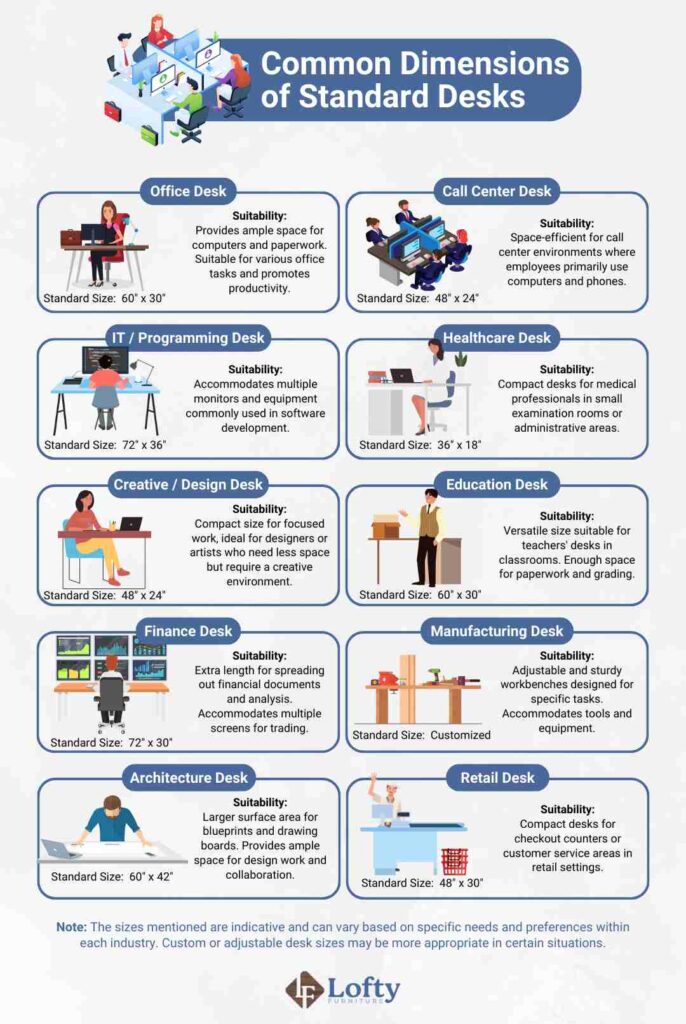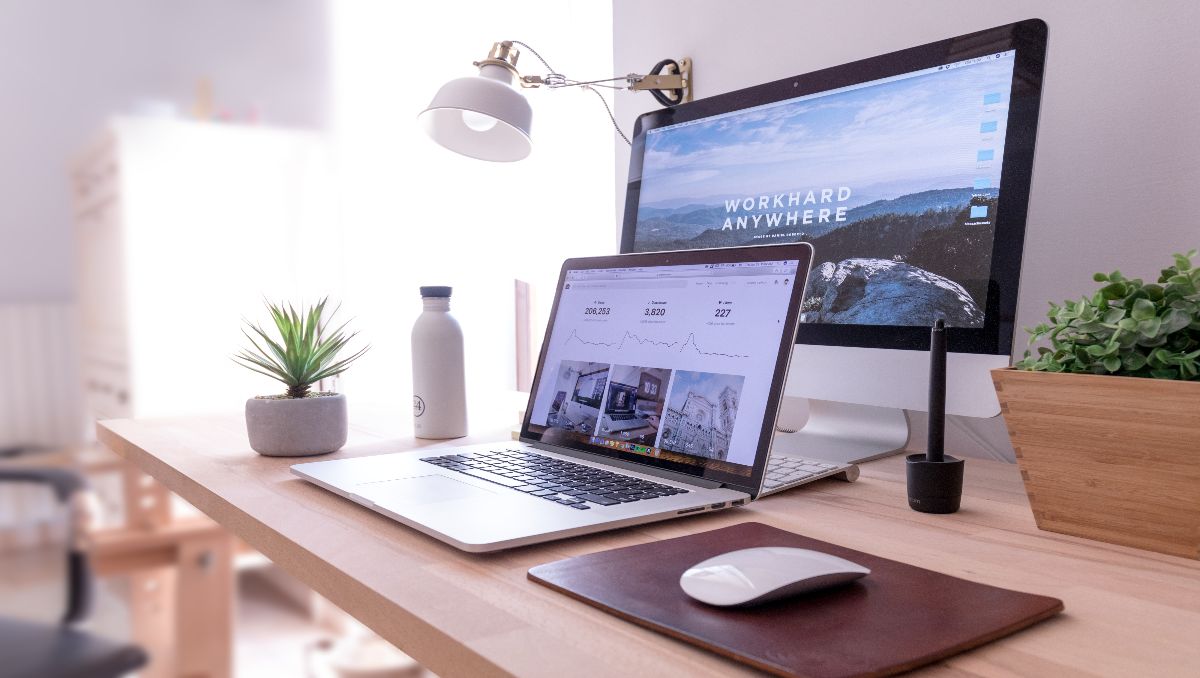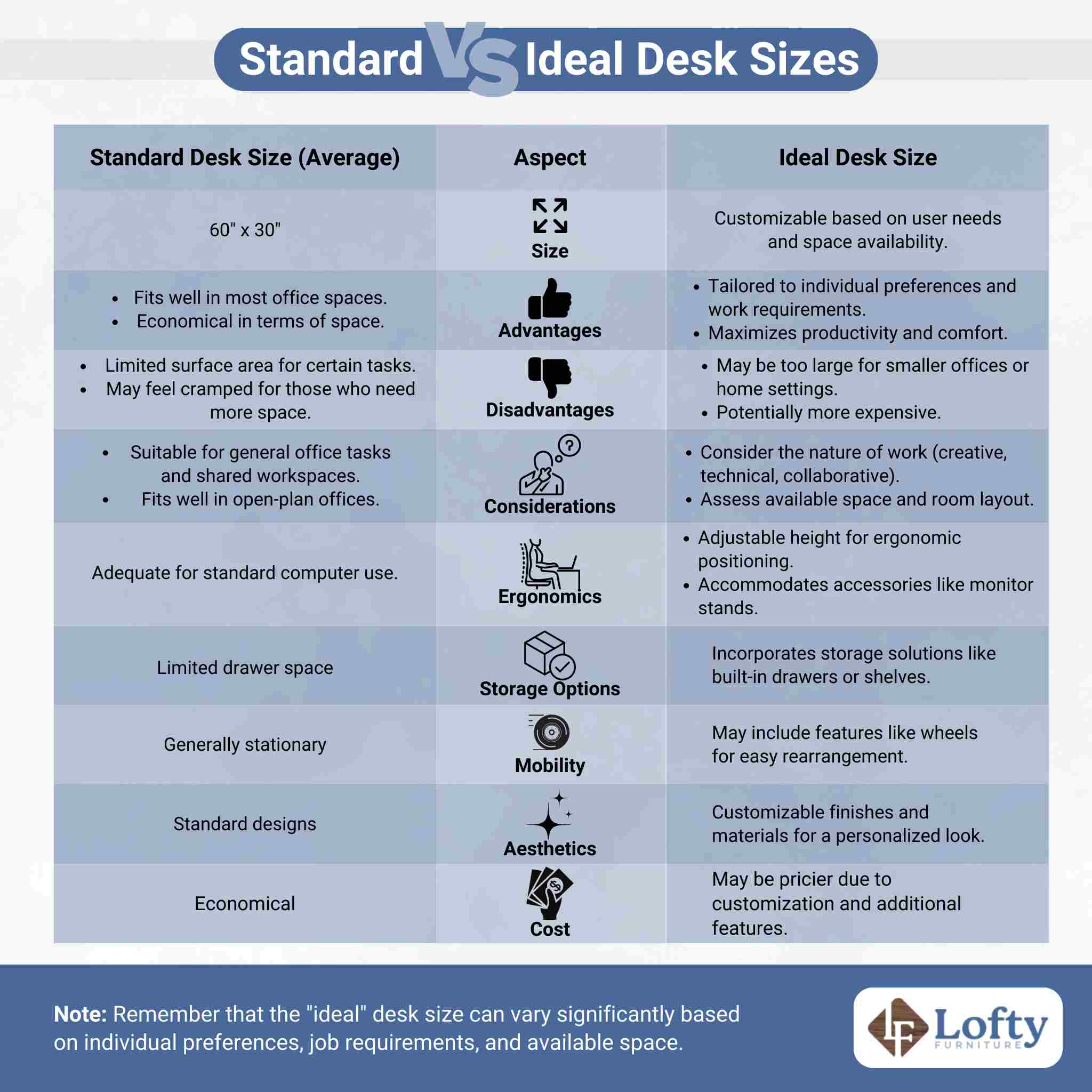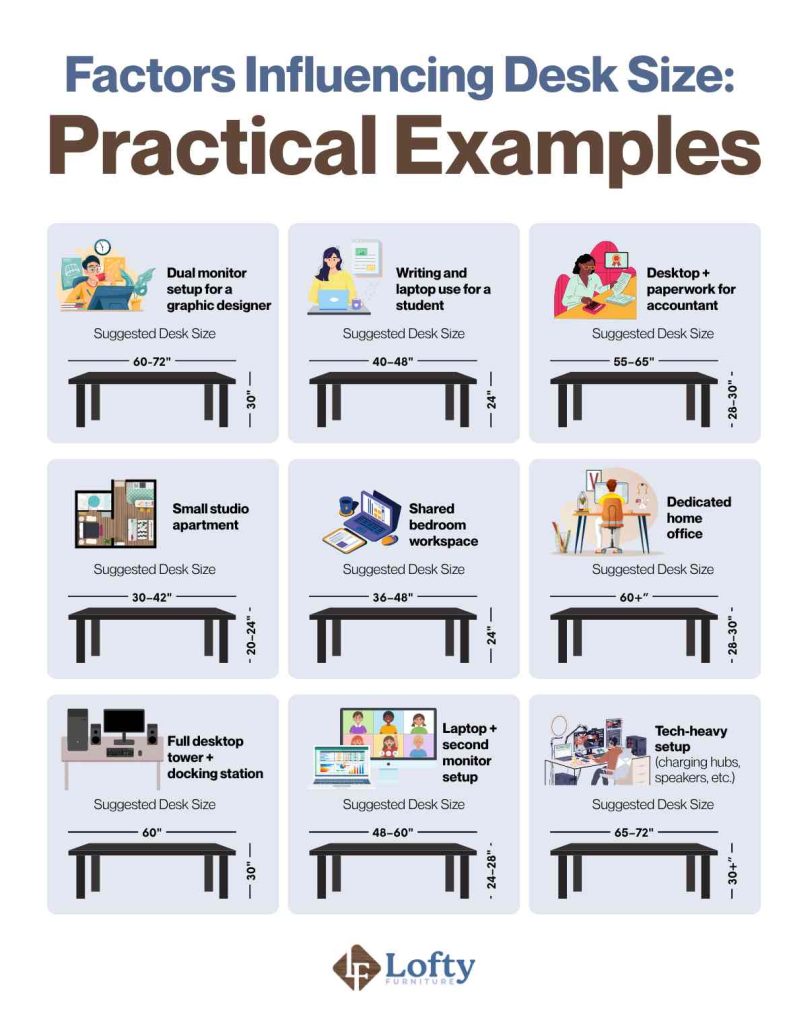When setting up a workspace, most people focus on the chair, computer, or decor, but the size of your desk matters just as much. Whether you’re working from home or furnishing an office, choosing between a standard desk and one that’s ideally suited to your needs can make a big difference in comfort, productivity, and posture. So, is there really a difference between standard and ideal desk sizes, or is it all just preference?
Key Takeaways:
- Ideal vs. standard desk sizes differ in that standard desks follow common dimensions suitable for most users, while ideal desk sizes are tailored to fit a person’s specific needs, body type, and workspace setup.
- Standard desk sizes adhere to industry norms with dimensions like 28-30 inches in height and 48-72 inches in width. The primary difference lies in customization.
In this article, we will explore standard desk sizes versus ideal desk sizes, discuss the factors that influence their dimensions, and provide guidance on choosing the right desk size for your needs.
Standard Desk Sizes
When it comes to standard desk sizes, there are some common dimensions that you should be aware of. These desk dimensions can vary based on the type of desk you are considering, such as a writing or computer desk.

Standard office desks are typically 28–30 inches high, 24–30 inches deep, and 48–72 inches wide, offering enough space for a computer, paperwork, and other essentials. Many include features like legroom, cable management, and a range of materials from dark wood to metal. Desk types vary — from compact computer desks to executive or adjustable standing desks — each with different sizes and features. Extras like keyboard trays, CPU holders, or height-adjustable designs can improve comfort, posture, and productivity, making it worth choosing a desk that fits both your space and workflow.
Pros and Cons of Standard Desks
One vital aspect to weigh when choosing a suitable desk is its size, which can significantly impact your comfort and productivity. Regarding desk sizes, there are pros and cons to consider.
A smaller desk can be beneficial if you have limited space or prefer a minimalist setup. It can also encourage better posture and reduce clutter. On the other hand, a larger desk provides more surface area for spreading out your work materials and allows for customization options such as adding extra monitors or storage solutions. However, it may take up more space in your room and might lead to a tendency to accumulate unnecessary items.
Ideal Desk Sizes
The ideal dimensions for desks can vary based on personal preferences, the type of work being done, and the available space. However, some common guidelines for desk dimensions can provide a comfortable and functional workspace for most people.
Here are general recommendations:

- Ideal desk height is typically around 28 to 30 inches (71 to 76 cm). Some adjustable desks allow users to customize the height to suit their comfort.
- The depth of a desk is often in the range of 20 to 30 inches (51 to 76 cm). Deeper desks provide more space for tasks and storage.
- Width can vary, but an ideal desk width is often between 40 and 60 inches (102 to 152 cm). Larger desks may be preferable for those who need more workspace.
- Consider the legroom and knee space under the desk, ensuring enough room for comfortable seating.
When choosing a desk, consider drawer and shelf dimensions, as well as the placement of your keyboard, mouse, and monitor for comfort. Adjustable desks offer flexibility, especially for multiple monitors or specialized tools. Custom features like height adjustments, monitor stands, and cable management help improve posture, reduce clutter, and keep you organized. Selecting materials, colors, and designs that suit your style while supporting your work habits can make a big difference in daily comfort and productivity.
Benefits of Having Ideal Desks
The benefits of having ideal desk sizes vs standard desk are numerous.
Firstly, customization options allow you to tailor the desk to your work requirements. Whether you need extra surface area for multiple monitors or storage compartments for organizing documents, an ideal desk can provide it all.
Secondly, ergonomic adjustments are vital in promoting better posture and reducing strain on your body. You can create a workspace that supports good health and productivity with adjustable height settings and ergonomic accessories like keyboard trays, desk mats, and monitor stands.
Factors Influencing Desk Size
When considering the factors that influence the size of your desk, there are three key points to consider. Considering these factors, you can ensure that your desk size perfectly suits your needs and preferences.

Work Requirements
Work requirements can vary greatly depending on the nature of your job and the tasks you perform daily. Space limitations are important when choosing a desk size, as you want to ensure that it fits comfortably in your workspace without feeling cramped.
Personal preferences also play a role, as some individuals prefer larger desks with plenty of surface area, while others may require more storage options. Budget considerations are another factor to keep in mind, as larger desks tend to be more expensive. Finally, productivity factors should be considered, such as having enough room to spread documents or set up multiple monitors if needed.
Available Space
Space optimization is crucial for creating an efficient and comfortable work environment. To maximize productivity, it is essential to plan your furniture layout carefully. Look for compact solutions that fit seamlessly into smaller spaces while providing ample workspace. Creative storage solutions are also important to keep your desk clutter-free and organized. Utilize shelves, drawers, and organizers to store all office supplies within arm’s reach.
By strategically incorporating these elements, you can make the most of the available space and create a functional and inviting workspace that meets your practical needs and aesthetic preferences.
Technology Integration
Integrating technology seamlessly into your workspace can boost both efficiency and comfort. Position your monitor at eye level to reduce neck and eye strain, and choose a comfortable keyboard and mouse for smoother typing and navigation. Use productivity tools like task management apps or digital calendars to stay organized, and keep cables tidy with clips or zip ties to prevent clutter and hazards. Adding a docking station or USB hub can also make it easier to connect and manage your devices, creating a more streamlined and ergonomic setup.

Why Desk Size Matters for Your Long-Term Health
Choosing the right desk size directly impacts posture and long-term musculoskeletal health. A desk that’s too high forces shoulder strain, while one that’s too low promotes hunching that’s linked to chronic back and neck pain.
Insufficient desk width can also cause wrist and forearm discomfort by restricting natural movement. Workers with insufficient desks may experience more repetitive stress injuries. Adjustable or L-shaped desks help mitigate these risks by accommodating proper monitor spacing and posture shifts. Always prioritize ergonomic alignment over compact designs for sustained comfort.
The Comparison: Standard vs Ideal Desk Sizes
When comparing the standard and ideal desk sizes, it is important to note their significant differences. Industry standards often determine standard desk dimensions and tend to be more generic in nature. On the other hand, ideal desk sizes consider ergonomic design principles that prioritize comfort and productivity.

How to Choose the Right Desk Size
It is crucial to find a desk that fits your space and promotes productivity and comfort. One of the first things to consider is customization options. Look for desks that offer adjustable features such as height, tilt, and storage solutions. These ergonomic adjustments can greatly enhance your working experience by allowing you to customize the desk to your needs.
Several factors influence the size of the desk you should choose. Firstly, consider your work requirements—are you mainly using a computer, or do you require additional space for paperwork or other equipment? Secondly, take into account the available space in your office or home.

Ready to combine timeless craftsmanship with personalized comfort? Explore our collection of Amish adjustable desks to find a desk that perfectly matches your ideal size requirements.
The Rise of Adjustable and Multi-Functional Desks
As work-from-home culture has taken root and hybrid setups have become the norm, the traditional desk is no longer the default. Adjustable and multi-functional desks are quickly gaining traction, offering flexibility that standard and even ideal-sized desks don’t always account for. Height-adjustable desks, also known as sit-stand desks, are especially popular due to their ergonomic and health benefits.
Beyond adjustability, many newer desks are designed to be multi-purpose. Some include modular storage that can be reconfigured, fold-away surfaces for small-space living, or built-in cable management and tech charging hubs. These features not only support better organization and workflow but also align with the growing trend toward minimalist and space-conscious home offices.
You might be interested to explore the best wood to build a desk.
Finding Your Fit: Ideal vs Standard Desk
In conclusion, when choosing the right desk size for your workspace, it is important to consider both standard and ideal dimensions.While standard sizes provide a baseline for functionality, ideal sizes take into account personal preferences and ergonomic factors. Factors like available space, work requirements, and body proportions should guide your decision-making process.
Remember, finding the perfect desk size is like finding the perfect pair of shoes – it should fit just right and make you feel comfortable throughout your workday.
Frequently Asked Questions
Are standing desks considered ‘ideal’ or ‘standard’ sizes?
Standing desks don’t fall neatly into either category. Many come with standard width and depth measurements, but their height adjustability and modular features push them closer to the “ideal” category, especially when tailored to individual needs.
Can I modify a standard desk to make it more ergonomic?
Yes, absolutely. You can improve the ergonomics of a standard desk with simple upgrades like a monitor riser, an adjustable chair, a keyboard tray, or a footrest.
What’s the best desk size for a dual monitor setup?
For a dual monitor setup, a desk width of at least 55 to 60 inches (140 to 150 cm) is recommended. This allows enough horizontal space for both screens without crowding, and leaves room for peripherals like a keyboard, mouse, and note-taking space. A depth of 28 to 30 inches (71 to 76 cm) also helps maintain proper viewing distance and posture.
How much desk space do I need if I mostly use a laptop?
If you’re primarily working on a laptop, a smaller desk with around 36 to 48 inches wide and 24 inches deep can be more than enough. Just make sure there’s still space for comfortable hand placement, any external devices, and accessories like a lamp or notebook.
